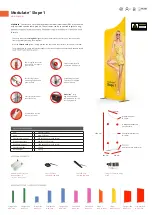
4
diatheses related to the use of anticoagulant therapy, and
malfunctions of the valve due to distortion at implant, fracture
of the Elgiloy wireform, or physical or chemical deterioration of
valve components. Types of tissue deterioration include
infection, calcification, thickening, perforation, degeneration,
suture abrasion, instrument trauma, and leaflet detachment
from the valve stent posts. These complications may present
clinically as abnormal heart murmur, shortness of breath,
exercise intolerance, dyspnea, orthopnea, anemia, fever,
arrhythmia, hemorrhage, transient ischemic attack, stroke,
paralysis, low cardiac output, pulmonary edema, congestive
heart failure, cardiac failure, and myocardial infarct.
Note:
Based on reports in the literature on tissue valves (Refs. 3,
18, 23, 26, 36, 48, 49 & 54), there appears to be an increased
incidence of leaflet calcification in patients under the age of 20.
In this regard, animal research studies (Ref. 11) show that a high
systemic calcium level can lead to early calcification.
Furthermore, at least one published report describes a potential
relationship between the consumption of daily calcium
supplements and early leaflet calcification in an adult (Ref. 34).
When feasible, repeated intravenous injections containing calcium
should be avoided during the postoperative period; and excessive
milk or dairy product consumption should be avoided in children.
There are no clinical data presently available demonstrating
increased resistance of Carpentier-Edwards PERIMOUNT Magna
pericardial bioprostheses to calcification as compared to other
commercially available bioprostheses.
6.2 Potential Adverse Events
Adverse events potentially associated with the use of
bioprosthetic heart valves include:
•
Angina
•
Cardiac arrhythmias
•
Endocarditis
•
Heart failure
•
Hemolysis
•
Hemolytic anemia
•
Hemorrhage
•
Myocardial infarction
•
Prosthesis leaflet entrapment (Impingement)
•
Prosthesis nonstructural dysfunction
•
Prosthesis pannus
•
Prosthesis perivalvular leak
•
Prosthesis regurgitation
•
Prosthesis structural deterioration
•
Prosthesis thrombosis
•
Stroke
•
Thromboembolism
It is possible that these complications could lead to:
•
Reoperation
•
Explantation
•
Permanent Disability
•
Death
7. Clinical Studies
Pre-Approval Patient Cohort
Clinical data, available on 719 patients requiring isolated aortic
valve replacement (AVR) with the Model 2700 Carpentier-Edwards
pericardial bioprosthesis with mean follow-up of 3.9 years, indicate
overall actuarial survival rate at 6 years of 73.7% ±2.0%. Clinical
data, available on 70 patients requiring double valve replacement
(DVR) with mean follow-up of 3.7 years, indicate overall actuarial
survival rate at 6 years of 67.2% ±6.5%. This pre-approval patient
cohort data was collected from the period between August 1981
and January 1989. In the isolated AVR population, there were a
total of 455 (63.3%) males and 264 (36.7%) females with a mean
age at implant (± standard deviation) of 64 (±12.4) years and a
range of 18 to 90 years. The indications for valve replacement were
stenosis (63.4%), regurgitation (16.3%), mixed disease (15.3%)
and previous prosthetic aortic valve dysfunction (5.0%).
In the DVR population, there were a total of 24 (34.3%) males
and 46 (65.7%) females with a mean age (± standard deviation)
of 62.9 (±12.7) years and a range of 31 to 94 years. The
indications for valve replacement were stenosis (45.7%),
regurgitation (25.7%), mixed disease (21.4%) and previous
prosthetic aortic valve dysfunction (7.4%).
The follow-up methods used at each clinic included hospital
visits, office visits and contact by telephone or letter with either
the patient, the patient’s family or local doctor.
Table 1 summarizes the operative and postoperative complication
rates for the isolated AVR and DVR populations. The operative
rates are based on 719 patients for the isolated AVR population
and on 70 patients for the DVR population. The postoperative
rates are based on 2767.9 and 255.8 years of follow-up occurring
>30 days after implant for the isolated AVR and DVR populations
respectively.
Table 2 presents, by valve size, the mean gradients and valve
areas reported in echocardiograms performed on patients in
this study population.
Information on preoperative and postoperative NYHA Functional
Class was gathered for the isolated AVR population. In
220 patients the NYHA was not reported (171 patients expired
and 49 patients not available). Of the 499 patients with reported
preoperative and postoperative NYHA Functional Class at the last
available follow up, 10 patients (2.0%) got worse, 59 patients
(11.8%) remained the same and 430 patients (86.2%) improved.
Table 3 presents data comparing preoperative NYHA Functional
Class to postoperative NYHA Functional Class at the last
available follow up.
149256001A_EN_ES_PT 16.2.2005 14:30 Uhr Seite 4





































